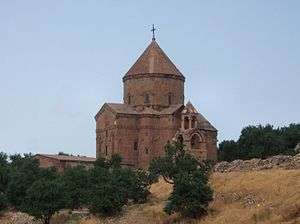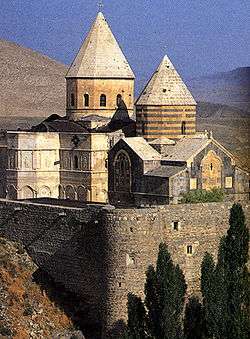Katarovank
| Katarovank Կատարովանք | |
|---|---|
 Shown within Nagorno-Karabakh Republic | |
| Basic information | |
| Location |
|
| Geographic coordinates | 39°30′10″N 46°47′33″E / 39.5027°N 46.7925°ECoordinates: 39°30′10″N 46°47′33″E / 39.5027°N 46.7925°E |
| Affiliation | Armenian Apostolic Church |
| Year consecrated | before 335 AD |
| Architectural description | |
| Architect(s) | yes |
| Architectural type | Monastery, Church |
| Architectural style | Armenian |
| Completed | 4th century, 17th century |
| Specifications | |
| Materials | sandstone |
Katarovank Monastery (Armenian: Կատարովանք ) is an ancient Armenian monastery in the Hadrut Region of the Nagorno-Karabakh Republic. It was founded in the 4th century. The present structure was completed in the 17th century.
History and architecture
The 5th century Armenian historian Pavstos Buzand, known for his six-volume History of Armenia, describes Katarovank as a large monastery built on top of the Dizapait Mountain. [1] Buzand mentions the monastery in the context of his story about the invasion of Armenia by the Massagetae and Huns in 335 AD. [2] In that year, a large army led by King Sanesan invaded Armenia’s eastern provinces as a reaction to the mission of St. Grigoris—the grandson of St. Gregory the Illuminator and bishop of eastern lands of Armenia. St. Grigoris led an Armenian mission to convert the Massagetae tribesmen into Christianity. The mission gained true success when the missionaries managed to turn three of Sanesan’s own sons into Christianity.
Suspicious of St. Grigoris, Sanesan ordered to execute the saint on the plain of Vatnean by tying him to a wild horse. His children fled the royal palace together with St. Grigoris’ missionaries who carried with them St. Grigoris’ body. The children decided to hide in the mountaintop Katarovank Monastery, which at the time hosted as many as 3870 hermits and pilgrims. [3] But Sanesan in his pursuit of the children reached the monastery and killed all the inhabitants of Katarovank, including his own children. The monastery was destroyed by the Hun soldiers and the corpses of the killed were burned.
The present-day chapel is a 17th-century structure. It is a single nave basilica constructed from the blocks of local coarse-cut sandstone. One side of the chapel is below the ground while the other is built on bare rock. There are Armenian khachkars near the chapel. The monastery offers a unique panoramic view to the southern part of the Nagorno Karabakh Republic, up to the River Araxes.
Books
- The Epic Histories: Attributed to P'awstos Buzand. Columbia University Press, Department of Near Eastern Languages and Civilizations, 1989
- Movses Kalankatuatsi. History of the Land of Aluank, translated from Old Armenian by Sh. V. Smbatian. Yerevan: Matenadaran (Institute of Ancient Manuscripts), 1984, Book I, chapter 14, in Russian.
- (in Italian) Documenti di architettura armena, Alexandr L. Jakobson – 1986 – 73 p.
See also
References
- ↑ The Epic Histories: Attributed to P'awstos Buzand. Columbia University Press, Department of Near Eastern Languages and Civilizations, 1989
- ↑ Mkrtchian, Shahen. Historical and Architectural Monuments of Nagorno Karabakh. Yerevan: Hayastan Publishing House, 1988, p. 100
- ↑ Mkrtchian, Shahen. Historical and Architectural Monuments of Nagorno Karabakh. Yerevan: Hayastan Publishing House, 1988, p. 100


